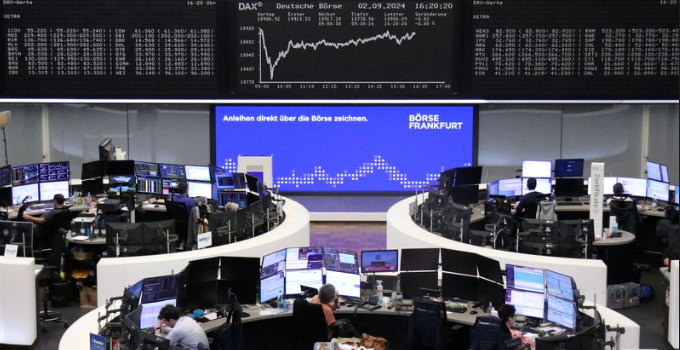
Date Issued – 2nd October 2024
Preview
Significant global events are shaping the macroeconomic landscape, we have seen key market movements from Hong Kong’s remarkable rally, fluctuations in oil and gold prices, and a major boost for Nike’s stock. This newsletter provides a deep dive into these developments, helping you assess their impact on your portfolios and take advantage of emerging opportunities in the current economic environment.
Hong Kong Market Rally: A 6% Surge
In an unexpected twist, the Hong Kong stock market has surged by 6% in the last 24 hours, marking one of the strongest rallies in recent months. This resurgence has been fueled by several key factors, including renewed optimism over China’s economic policies and investor enthusiasm following positive developments in Hong Kong’s real estate sector. Speculation surrounding easing regulations in China’s tech industry also bolstered investor confidence, with major tech stocks such as Tencent and Alibaba rebounding sharply.
Additionally, Chinese policymakers are signaling further support for the embattled property market and offering targeted stimulus to revive consumer spending. The People’s Bank of China hinted at a more accommodative monetary policy stance, aiming to inject liquidity into the financial system, which spurred a wave of buying from both domestic and foreign investors.
Hang Seng Index (HSI): 22’443.73
Investment Insight
Technology Stocks: Given the rally’s emphasis on tech and real estate, investors might consider increasing exposure to Chinese technology giants, as their fundamentals remain strong despite regulatory headwinds over the past year.
Real Estate & Financials: Hong Kong’s recovery, particularly in the property sector, signals potential gains in financial services and real estate-linked equities. However, ongoing regulatory risks remain, so a balanced approach is advised.
Oil & Gold Prices: Market Movements Amid Uncertainty
Oil and gold markets have experienced notable volatility over the past 24 hours, reflecting ongoing uncertainty in the global economy and geopolitical landscape.
Oil: Crude oil prices have increased slightly, trading around $90 per barrel after concerns about potential supply disruptions in the Middle East. Israel’s ongoing military operations in Lebanon, paired with the threat of escalations in the region, have put pressure on oil markets, stoking fears of reduced output from major producers in the Gulf. Additionally, OPEC+ continues to signal that they will maintain production cuts through the end of 2024, further tightening global supplies.
Gold: Meanwhile, gold prices rose by 1.5% over the past day, hitting $1,900 per ounce. The price increase is primarily driven by renewed investor interest in safe-haven assets due to mounting geopolitical tensions and concerns about inflation, particularly as the U.S. dollar remains strong. With inflationary pressures persisting in the U.S. and Europe, investors are turning to gold to hedge against future economic uncertainties.
Investment Insight
Energy Stocks & Commodities: The continued uncertainty in the Middle East could push oil prices higher, benefiting energy stocks, particularly oil producers and energy service companies. Investors may want to consider adding commodities or energy-focused ETFs to hedge against potential supply disruptions.
Gold as a Hedge: Given the sustained demand for safe-haven assets, gold remains an essential part of a diversified portfolio, especially in times of geopolitical tension and economic volatility. Holding a position in gold or gold-related assets, such as mining stocks, can provide protection against inflationary risks.

Nike Stock Falls Following Withdrawal of Full-Year Outlook
Nike’s stock took a significant hit, dropping over 7% after the company announced it would be withdrawing its full-year financial outlook, citing the upcoming CEO transition. This came despite Nike’s fiscal Q1 2025 net income of $1.1 billion, which exceeded analyst expectations. However, revenue fell 10% year-over-year, landing at $11.59 billion, missing forecasts. Nike’s guidance for the second quarter also disappointed, with the company expecting an additional revenue decline of 8% to 10%, further contributing to investor unease.
Nike’s decision to postpone its investor day, originally scheduled for November 19, and its lower-than-expected revenue guidance added to market concerns, creating short-term uncertainty about the company’s direction under its incoming CEO. While the company highlighted some positive developments in innovation and key sports momentum, these early gains were not enough to alleviate concerns about future earnings.
Nike Inc (NKE): 89.13
Investment Insight
Given this uncertainty, investors should monitor Nike closely during its leadership transition. The company’s long-term prospects in innovation and digital transformation remain strong, but the short-term outlook may experience volatility until clearer guidance is provided.
U.S. Government Shutdown Avoided: A Temporary Relief
In a significant political development, the U.S. Congress has narrowly avoided a government shutdown by passing a temporary funding bill. The bill, which extends government funding through mid-November, provides a brief reprieve but does not address long-term budget concerns. The looming issue of government spending will resurface later in the year, creating potential volatility in markets dependent on federal contracts, such as defense, infrastructure, and healthcare.
While the short-term impact of avoiding a shutdown has been positive, with markets reacting favorably to the news, the uncertainty surrounding future negotiations could weigh on investor sentiment in the coming months.
Investment Insight
Defense & Infrastructure Stocks: Investors should remain cautious about sectors heavily reliant on government spending, such as defense contractors and infrastructure companies, as future budget negotiations could result in reduced spending or delays in contract awards.
U.S. Treasuries: The ongoing budget uncertainty may increase demand for U.S. Treasuries as investors seek safe-haven assets during periods of fiscal instability. Adding bonds or bond ETFs could provide stability in the face of potential political gridlock.
Global Economic Slowdowns: Warning Signs in India
Recent data indicates a sharp slowdown in the Indian economy, with several key sectors flashing warning signs. In August, consumer demand contracted across critical areas such as passenger vehicles, domestic air travel, and broadband subscribers. The Mint macro tracker, which monitors 16 high-frequency economic indicators, showed that seven indicators were in the red, reflecting a more significant deterioration than previously expected.
India’s challenges are compounded by its reliance on Chinese imports for raw materials and intermediary goods, creating a precarious balance as it attempts to reduce dependence on its largest trading partner while still addressing internal supply chain issues.
Investment Insight
Emerging Markets: India’s slowdown serves as a cautionary tale for investors with significant exposure to emerging markets. Diversification across regions may be necessary to mitigate risks stemming from any single market’s economic troubles.
Technology & Infrastructure: Despite the broader slowdown, technology and infrastructure remain bright spots in India’s economy, with government initiatives focused on boosting domestic manufacturing and digital infrastructure. Investors might explore opportunities in these sectors, which are likely to benefit from long-term structural reforms.
Conclusion thoughts: Staying Agile in a Dynamic Environment
As global markets continue to face uncertainty from labor strikes, geopolitical tensions, and fluctuating economic data, it’s essential to stay informed and adapt to these fast-changing conditions. The rally in Hong Kong, fluctuations in commodity markets, and corporate performance from companies like Nike provide a mixture of both risks and opportunities.
We will continue to monitor these developments closely and provide timely insights to help you navigate the current market landscape. As always, please feel free to reach out if you have any questions or would like to discuss potential portfolio adjustments.
Upcoming Dates to Watch
- October 15: U.S. inflation report and potential Fed policy adjustments.
- November 1: Deadline for the U.S. government’s long-term budget agreement.
- Q4 2024: China’s next round of economic stimulus measures and their impact on global markets.
Find below some of our Buy/Sell Recommendations. Balfour Capital Group is a distinguished global boutique investment management firm with $400 million AUM and over 1000 Clients.

Disclaimer: This post provides financial insights for informational purposes only. It does not constitute financial advice or recommendations for investment decisions.

